Wind in her sails: SailGP on its plans to exploit even more data points for fan engagement in the upcoming season
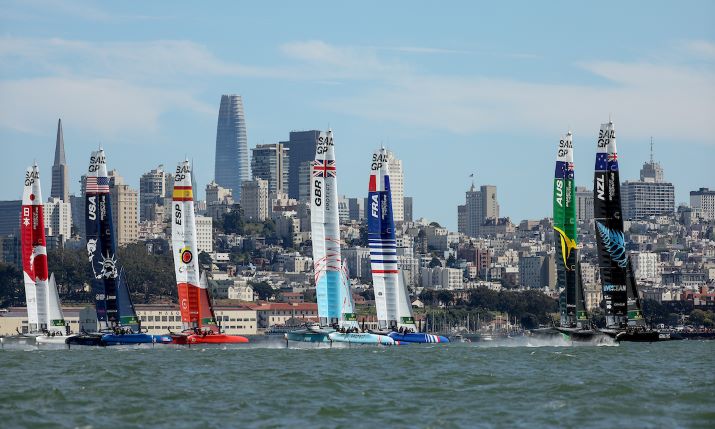
SailGP’s season two finale happened in San Francisco on 26 to 27 March
SailGP season three is returning to our screens on 14 May as this thrilling wind-powered racing series takes to the seas around Bermuda. SVG Europe caught up with SailGP’s director of technology, Warren Jones, to find out what we might expect to see coming up in the broadcast of the new season.
On SailGP’s second season which closed at the end of March 2022 in San Francisco, Jones comments on what the main learnings were from the mass of new broadcast technologies implemented during the period.
He says: “Going back to the first event in season two, the UK was under lockdown. As we were leaving the UK, we were greeted by police telling us that we are not allowed to leave. We had to have a document saying that we’re working overseas, so for that point alone, to get out of the country to do a TV global event in another was extremely difficult.
“For us not to be able to travel with huge amounts of people like we used to, and have people working from London and being able to work in their homes around the UK or around the world, connecting to London to do what they needed to do, was really, really important because I don’t think we’d be able to get the Bermuda and the Toronto events away without [remote broadcast] technology.”
“We’re extremely lucky that we started [SailGP] with a blank sheet of paper, and therefore we could push it into a direction where we wanted to go and we didn’t have the constraints of legacy software, legacy hardware, and all these type of things. We’re constantly looking and trying to iterate these improvements and be more sustainable and more efficient in how we do things”
Timeline TV has facilitated SailGP’s epic remote production since its first season. Notes Jones: “We’ve been working with Timeline from the start and we’re going into our third year with them. We’re really, really proud to be working with these guys and girls because we can throw them a problem and say, “we want to do something a little bit differently”, and they huff and puff a little bit, and then they say, “yeah, this is probably the right way to go”. The people there are really, really collaborative. It works well for SailGP and Timeline.”
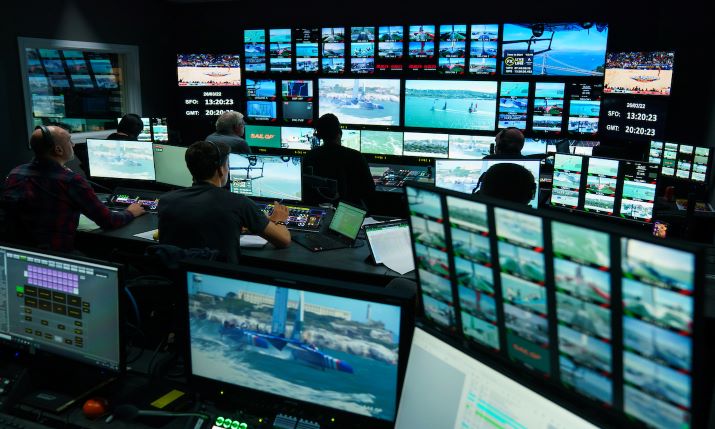
Timeline TV has facilitated SailGP’s epic remote production since its first season. Here crew are hard at work during season two form the London, Ealing Timeline TV studios
Exploiting the data points
Part of what is being further developed for season three is the use of the masses of data generated by the boats while racing. Says Jones: “We have around 30,000 data points per F50, the sailboat that the athletes compete in. From that, we generate around 40 billion data requests every afternoon, once the boats are out there [on the water]. So we’ve over-engineered the F50’s in a way. When we produced the boat and created the architecture of the data, [we’re still looking at] where that all that data goes into the Oracle Cloud, and how can we utilise more information from it.
“We’re constantly looking at the data. What information can this tell us? Where can this go? How can we make the boat go faster? And we’re also looking now about the sustainability angles of it; we know the wind [speed], the water temperature, all this around [the boats], and we’re open to giving this information to local sustainability partners in venues. We can use that to test when we go back in the following year, or over a certain amount of time, as well, so that’s quite interesting; it’s the first time we’re not using technology to make the boat go faster. We’re actually using it to monitor other things around the environment.”
Currently, only around 25% of the data generated by the F50’s is utilised, which is invested heavily in tracking the boats and course in real time and translating that information into augmented reality graphics to give viewers a strong sense of what is happening on the screen.
Jones says: “We’re not in a football field where we have a goal and a halfway line. We work on the water, so we use augmented reality graphics that we introduced in 2021. We need to know everything about the racecourse; we need to know where the boats are and we need to know within one centimetre where the boats are. We need to know where the marks are. We need to know where the everything is. From that information, everything goes into the Oracle Cloud and from the Oracle Cloud then we draw a map of what that [racecourse] looks like in a virtual world.”
As to what SailGP could do with the 75% of unused data, Jones says, “there’s tons of stuff we want to do”. He goes on: “There’s a couple of things [I would really like to do]. I can’t really talk about it at the moment, but there’s some things that we think are going to probably blow the broadcast industry away; we think it’s something that will revolutionise a lot of it. We’re doing some testing in Bermuda, and we’re also doing some testing in Chicago. We’ll review those tests and then we will probably look to release those tests to the public.”
Looking at season three, Jones says that a large focus will be placed on exploiting more of the data points created by the F50’s. “For season three, we’re looking to double down on our data. In partnership with Oracle, we have a platform called SailGP Insights. [We’re going to be] utilising more data and letting the fan go behind the scenes and look at that data and be able to choose what data they want to see, in conjunction with video, as well.
“We’re looking to push that data aspect, that second screen of people that have an ability to watch on Sky Sports [for instance] and then delve deeper in as the racing [goes on] and understand [more about] the behind the scenes [information on] what’s going on on the boats. There’s also a webpage – sailgpinsights.com – on which you’ll be able to look at video, our umpire in-camera – so how the umpire’s just made the on-field decisions on the race – and then look at data, so it’s pretty different.
“But we want to put that in the hands of the user or the fan, [so they can] decide what data they want to see. We’ve got 30,000 [points] of them, so they’ve got lot of choosing to do.”
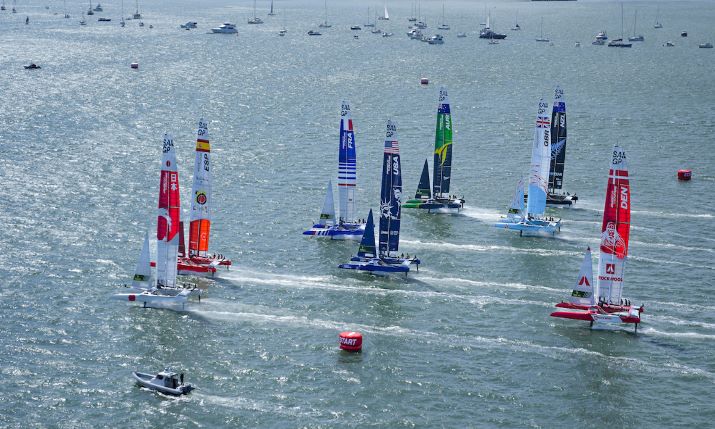 Centralised umpire team evolution
Centralised umpire team evolution
Other than the data push, “it’s just doubling down on what we do,” notes Jones. He goes on: “Last year there was a huge amount [of change].”
One of those changes was keep all SailGP umpires centralised on the UK, working remotely on races. Jones explains: “[Last season] we decided to bring our umpiring team back to London; historically they would all be on site and they’d be monitoring everything. Now they’re all back in London and they monitor everything from London, so having the communications from London to Sydney, and talking to the boats, and making decisions or pressing a penalty and there’s a red bulb that flashes on an F50 in Sydney. We’ve really refined all those workflows.
“We’ve always thought that we would be able to give them more information from a studio rather than a facility in a venue. COVID accelerated that and gave us the option to do that, but now the team are fully focused on utilising that technology and workflow. I was lucky enough to see one of our umpires, and I said, “do you still want to come to the site?” and he said, “no, I’m very happy in my booth in London, and I get so much more information to be able to officiate on a SailGP race”.”
This workflow has also enabled SailGP to train new umpires, comments Jones: “[Before] we couldn’t train people up; we didn’t have the possibility of having more umpires and training future umpires going forward. Now [using the remote workflow] we’ve got a team [of trainee umpires] in Utah, USA, the Netherlands and Croatia, and they basically watch what the [umpire] team in London are doing and then learn from that, [so they] then have the ability in the future to officiate races on behalf of SailGP.”
Keeping the fans focused
Informing and attracting new fans for season two is a key focus for SailGP. Jones says: “It’s a really interesting point because we do the augmented reality graphics, and we think that provides the ability [for new viewers] to really work out what’s going on on the racecourse. Sailing is a complex sport, and when you’re just looking at the boats on the water it’s pretty difficult to work out which way one is going and where it’s coming from. So using augmented reality to give you that [information, viewers can understand that] this boat is going here, that’s going there. We’re constantly moving forward with that, as well.
“In season two we introduced what we call a LiveLine boundary. So we have a boundary of play for season three. That actually completes the field of play, so everybody knows where [the boats are] racing.”
The LiveLine boundary is a virtual wall that identifies the field of play for the TV audience. As well as enabling SailGP to brand the boundary with SailGP partners for desired exposure, LiveLine is essentially the SailGP equivalent of a digital perimeter board at a football stadium.
Jones says there will be developments coming on LiveLine boundary: “We’ve also got a couple of changes we’re looking at; how the wind looks and how to visualise the wind, because we need wind to move these spectacular boats around a racecourse, [but as a viewer] how do we decide where the wind is? So we use augmented reality. We’re looking to try and showcase to the viewer that [the Australian team, for instance] picked the right side of the course, because there’s more wind on that side of the course.”
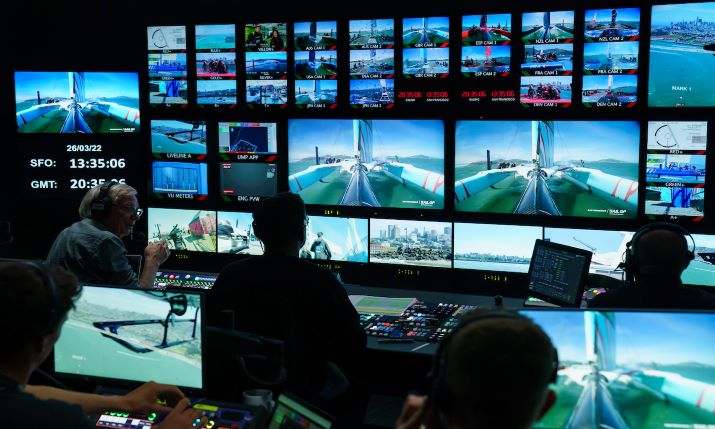
Timeline TV’s remote production workflow for SailGP has enabled it to continuously push its sustainability goals season on season
Cutting edge camera development
One technological development that was announced recently around SailGP is the Riedel Communications collaboration with the series and Skyroads, a provider of automated flight technologies, to deliver new and more immersive imagery as well as a substantially reduced CO2 footprints.
Announced during SailGP’s season two Grand Final in San Francisco on 26 to 27 March, Riedel and Skyroads are entering into a strategic alliance to deliver a $20 million order of Skybot-Cam systems, which combine high payload drones with professional broadcast gyro stabilised camera systems with live video, audio, and data downlinks.
The plan is for Skybot-Cam to be introduced at SailGP, which will be the first global event in the world to use the new technology. SailGP will facilitate and support the test operation of this system, and after an exclusive implementation at SailGP in 2024, the Skybot-Cam will become available for all public events. The technology will be used with SailGP’s award-winning augmented reality LiveLineFX graphics package.
Jones comments: “The Riedel with the Skyroads partnership is [because] we want be more green in what we do. And because we can’t, like in football, [use] camera one as their main camera one the halfway line. Ours are up in the sky, so we need more cameras and more better ways of following the racing, as well.
“So we’re looking to partner with [Riedel with the Skyroads] and see if we can utilise their technology, but I think we’re a couple of years away from that point [being realised]. But we want to work together to get to the ability for us to put something up in the air and therefore then film the races in a new way, rather than just use a helicopter.”
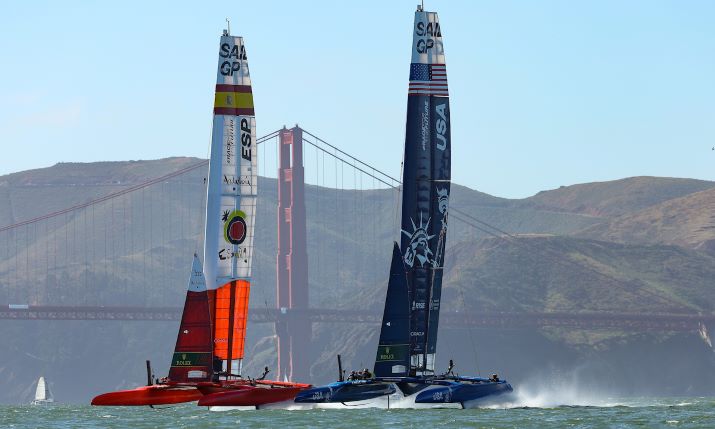
Cutting through the water at the season two Grand Final in San Francisco, two SailGP teams in their F50’s battle for the lead
Evolving sustainability through workflows
As to how SailGP is furthering its sustainability goals for season three on the broadcast, Jones says: “It’s quite interesting. We started remote production in 2019, before COVID. [At that time] the industry wasn’t in that position yet to say, “Well, this is sustainable. This can happen. We can do that”.
“I remember our first event in Australia. It was the worst possible place to do a remote production for the first time. Our studio is in London, we were in Australia, and we did that in 2019. So as the world changed with COVID, where we couldn’t get people to these locations, people started to look at the technology and really trust in the technology. This was available. This could work.
“In mainstream media, I remember watching the news and just seeing people being interviewed on mobile phones with 4G connections. Before COVID, this would never happen; there would be a satellite track outside. There would be a reporter there. So people were starting to learn and understand the technology, and utilise that technology. So now, for us, it’s quite easy to say to someone, “we think that you’d be better off to work from London, to have the continuity using the same workspace, the same systems, the same workflows, rather than chop and change and using different tracks, or different locations, or different time zones,” and things like that.”
He goes on: “For us now, it’s easier than what it was before. We’re constantly looking at our workflows and how we do things and say, “how can that person be better at doing something differently, or changing it like that?”. [For instance] in San Francisco, we had 100 people working for Timeline on our show. So that’s 200 flights, because they have all got to [get there and] fly home, as well. That’s 100 hotel rooms. That’s 200 taxis from the airport to the hotel, hotel to the airport. So in theory, by making a lot of people’s lives a little bit easier and a bit more constant [through the use of] technology, we’re saving a bit of CO2 from people [not] travel around the world.”
Concluding, Jones says that the series has been lucky to have started out at a time when so many interesting technologies were becoming available: “It’s just that we try and look at things and we’re extremely lucky that we started [SailGP] with a blank sheet of paper, and therefore we could push it into a direction where we wanted to go and we didn’t have the constraints of legacy software, legacy hardware, and all these type of things. We’re constantly looking and trying to iterate these improvements and be more sustainable and more efficient in how we do things.”
Season three of SailGP begins with the Bermuda Sail Grand Prix on 14 to 15 May 2022
